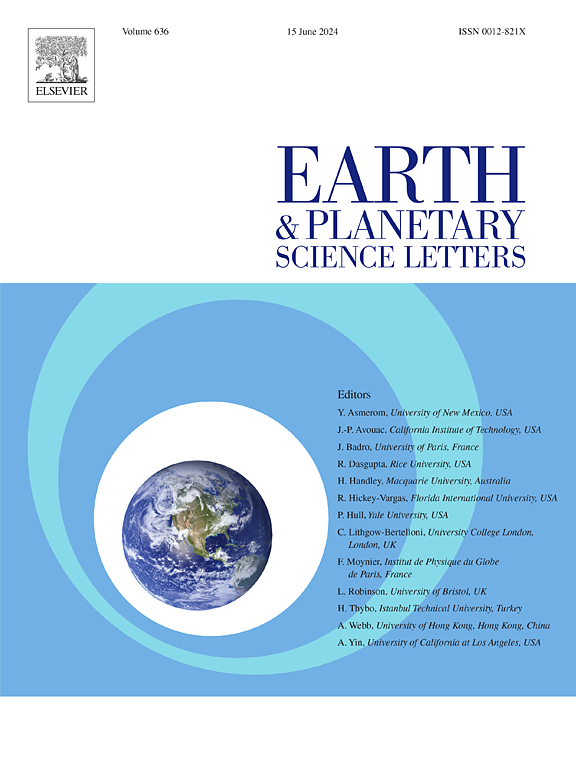Geology constrains the diffusivity of Ti in quartz and crystallization timescales of high-silica magmas in the Searchlight Magmatic System (NV, USA)
IF 4.8
1区 地球科学
Q1 GEOCHEMISTRY & GEOPHYSICS
引用次数: 0
Abstract
Many methods and mineral phases have been used to estimate crystallization timescales of high-silica magmas (≥68 wt. % SiO2), which source some of the most impactful volcanic eruptions on Earth and are a significant component of Earth’s continental crust. Results from these efforts vary widely (101-106 a), with a particularly large disparity between results from zircon geochronology and quartz geospeedometry. Quartz is widespread in high-silica magmas, and Ti-in-quartz diffusion chronometry is a commonly applied geospeedometer. However, recent work re-examining the diffusivity of Ti in quartz has introduced substantial uncertainty into our understanding of this parameter, and estimates of the diffusivity now vary by many orders of magnitude for the same temperature. This has all but eliminated the utility of this technique until this discrepancy can be resolved. In this work, we leverage field relations, geochronology, geobarometry, geochemistry, heat loss models, and crystal growth rates to establish limits on the crystallization timescales and conditions of high-silica extrusive (rhyolite) and intrusive (leucogranite) magmas in the Searchlight Magmatic System (NV, USA), which is comprised of the tectonically tilted Searchlight pluton and coeval Highland Range volcanics. We use these limits to critically assess Ti-in-quartz diffusion laws and constrain the diffusivity of Ti in quartz in this system. We conclude that only the fastest Ti-in-quartz diffusion laws produce timescales consistent with other geological constraints and that the crystallization times of the high-silica magmas were substantially shorter (rhyolite: <10 ka, leucogranite: ≤51 ka) than the mushes (150-200 ka) from which they were segregated.
探照灯岩浆系统(NV, USA)石英中Ti扩散率及高硅质岩浆结晶时间尺度的地质约束
许多方法和矿物相已被用于估计高硅岩浆(SiO2≥68 wt. %)的结晶时间尺度,这些岩浆是地球上一些最具影响力的火山爆发的来源,也是地球大陆地壳的重要组成部分。这些努力的结果差异很大(101-106 a),锆石地质年代学和石英地质测速学的结果差异尤其大。石英广泛存在于高硅质岩浆中,石英中钛扩散时计是一种常用的地速计。然而,最近重新研究石英中Ti的扩散系数的工作给我们对这一参数的理解带来了实质性的不确定性,并且在相同温度下对扩散系数的估计现在变化了许多数量级。在解决这个差异之前,这几乎消除了该技术的效用。在这项工作中,我们利用野外关系、地质年代学、地球化学、热损失模型和晶体生长速率,建立了由构造倾斜的探照灯岩体和同时期的高原山脉火山组成的探照灯岩浆系统(NV)中高硅挤出(流流岩)和侵入(浅花岗岩)岩浆的结晶时间尺度和条件的限制。我们使用这些限制来严格评估钛在石英中的扩散规律,并限制该系统中钛在石英中的扩散率。我们得出的结论是,只有石英中钛扩散速度最快的岩浆才能产生与其他地质约束条件一致的时间尺度,并且高硅质岩浆的结晶时间(流纹岩:10 ka,浅花岗岩体:≤51 ka)比它们分离出来的泥质岩浆(150-200 ka)要短得多。
本文章由计算机程序翻译,如有差异,请以英文原文为准。
求助全文
约1分钟内获得全文
求助全文
来源期刊

Earth and Planetary Science Letters
地学-地球化学与地球物理
CiteScore
10.30
自引率
5.70%
发文量
475
审稿时长
2.8 months
期刊介绍:
Earth and Planetary Science Letters (EPSL) is a leading journal for researchers across the entire Earth and planetary sciences community. It publishes concise, exciting, high-impact articles ("Letters") of broad interest. Its focus is on physical and chemical processes, the evolution and general properties of the Earth and planets - from their deep interiors to their atmospheres. EPSL also includes a Frontiers section, featuring invited high-profile synthesis articles by leading experts on timely topics to bring cutting-edge research to the wider community.
 求助内容:
求助内容: 应助结果提醒方式:
应助结果提醒方式:


